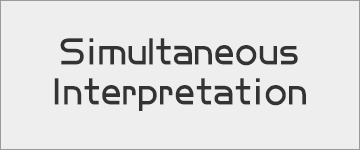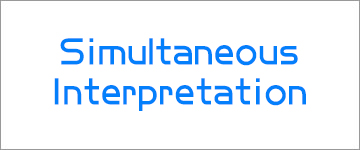
Interpretation services cover legal interpretation, on-site interpretation, business escort, consecutive interpretation, simultaneous interpretation. It covers business talks, interview, exhibition, international conference,press conferences, academic discussion, etc.
With le bleu concis, customers could depend on fluent on-site interpretion for all occasions. Our linguists are experienced in diverse fields for a comprehensive in-person language solution. We are quality, efficient and fast.
Consecutive Interpretion (CI) is also known as dialogue interpreting. In this mode, the interpreter listens to the message in the source language and interprets it in the target language so that both speakers, who do not speak a common language, can effectively communicate.
Simultaneous Interpretation (SI) is when an interpreter translates the message from the source language to the target language in real-time. Unlike in consecutive interpretion, natural flow of the speaker is not disturbed and it allows for a fairly smooth output for listeners.
Simultaneous interpretation is an extremely difficult interlingual transfer activity that is strictly limited by time. It requires the translator to quickly predict, understand, memorize, and predict the source language information with the help of existing subject knowledge while listening to the source language speech. Conversion and the planning, organization, expression, monitoring and correction of the target language, and the target language translation are spoken simultaneously, so simultaneous interpretation is also called simultaneous interpretation.
At various international conferences, simultaneous interpreters have used their "lightning-speed thinking" and impressive interpreting skills to successfully overcome the energy shortage and attention caused to the brain by the interweaving, overlapping and interference of the above-mentioned multi-tasking. Difficulty in power distribution makes listening and speaking go hand in hand, making him as eye-catching a star as the source language speaker. According to the regulations of the AIIC (International Association of Conference Interpreters), a simultaneous interpreter is considered qualified as long as he can translate 80% of the speaker's content (it is of course possible for a simultaneous interpreter to translate 90% or 100% of the speaker's content), because many People usually speak very fast, and when giving speeches, they only care about the content of their speech or the accents from different places. Simultaneous interpreters have to mobilize all their knowledge reserves and experience to give their best. After all, there are not too many speakers who intentionally slow down to accommodate simultaneous interpreters, which places extremely high demands on the quality of practitioners.
The biggest advantage of simultaneous interpretation is its high efficiency, which can ensure that the speaker speaks coherently without affecting or interrupting the speaker's train of thought, and helps the audience fully understand the full text of the speech. Simultaneous interpretation is a popular translation method in the world today. It is highly academic and professional and is usually used in formal international conferences. Currently, 95% of international conferences in the world use simultaneous interpretation. The characteristic is that the speaker speaks continuously, and the translator listens and translates at the same time. The average time between the original text and the target text is three to four seconds, and can reach more than ten seconds at most. The translator only uses the pause between the speaker's two sentences to complete the translation work, so the quality requirements for the translator are very high.
With its unique talent advantages, regional advantages and excellent service quality, Jingdian Translation Company provides hundreds of high-end simultaneous interpretation services to customers in Beijing, Shanghai, Nanjing, Suzhou, Shenzhen, Guangzhou and other places every year. Since 2005, we Our customer complaint rate is zero. Our simultaneous interpreters’ excellent translation skills and on-the-spot performance have greatly impressed our customers.
Simultaneous interpreter quality requirements:
(1) Bilingual
translators are the bridge between the speaker and the addressee. Must be very proficient in the source language and target language (bilingual). But what does mastery mean? Is it listening and speaking or reading and writing? Generally speaking, this refers to the ability to think bilingually, the proficiency in using bilingual grammar and rhetoric knowledge, proficiency in speaking, and rich knowledge of national conditions. It should be noted that bilingual proficiency is only a necessary condition for becoming a simultaneous interpreter, but not a sufficient condition. This is because of the special interpretation method of simultaneous interpretation.
(2) The process of translation in professional fields
is not just a superficial syntactic conversion process, but a deep semantic conversion process. Therefore, simultaneous interpreters must have certain knowledge in the professional field and be familiar with the professional terminology of simultaneous interpretation in the field in which they are engaged, in order to successfully complete the simultaneous interpretation task.
(3) Psychological quality
Psychological quality refers to the sum of states, qualities and abilities in a person's psychological process and personality psychological structure, including intellectual factors and non-intellectual factors. Intellectual factors include genetic factors, perception, memory, thinking, imagination, memory, etc. Non-intellectual factors include mental health status, mental endurance, adaptability and mental habits. Simultaneous interpreters must first have good intellectual factors, that is, keen perception of language, strong memory (especially short-term memory), and rich imagination. In terms of non-intellectual factors, we should develop a calm and decisive translation style, which is fundamentally about developing good psychological endurance.
(4) Physiological quality
The simultaneous interpretation process is a high-level neural activity process controlled by the brain. It requires the interpreter to be highly concentrated and reasonably allocate his attention between listening, speaking, thinking, translating, and watching (looking at the speaker's mouth shape and facial expressions). It requires both mental and physical strength to bear strong mental and physical pressure. Simultaneous interpreters must have excellent hearing and eloquent speech, as well as good concentration and short-term memory. Attention is the direction and concentration of mental activities on certain things, and is the basic condition for intellectual activities. Not being affected by the environment and being able to concentrate quickly in a new environment are important psychological qualities for simultaneous interpreters. Simultaneous interpreters should learn to shift their attention in a timely manner. If they encounter words they do not understand, they should quickly give up their habitual thinking and turn their attention to the next word or sentence.
Simultaneous interpretation field:
Foreign affairs activities, new product release receptions, training lectures, television broadcasts, international arbitration, large-scale international conferences, etc.











